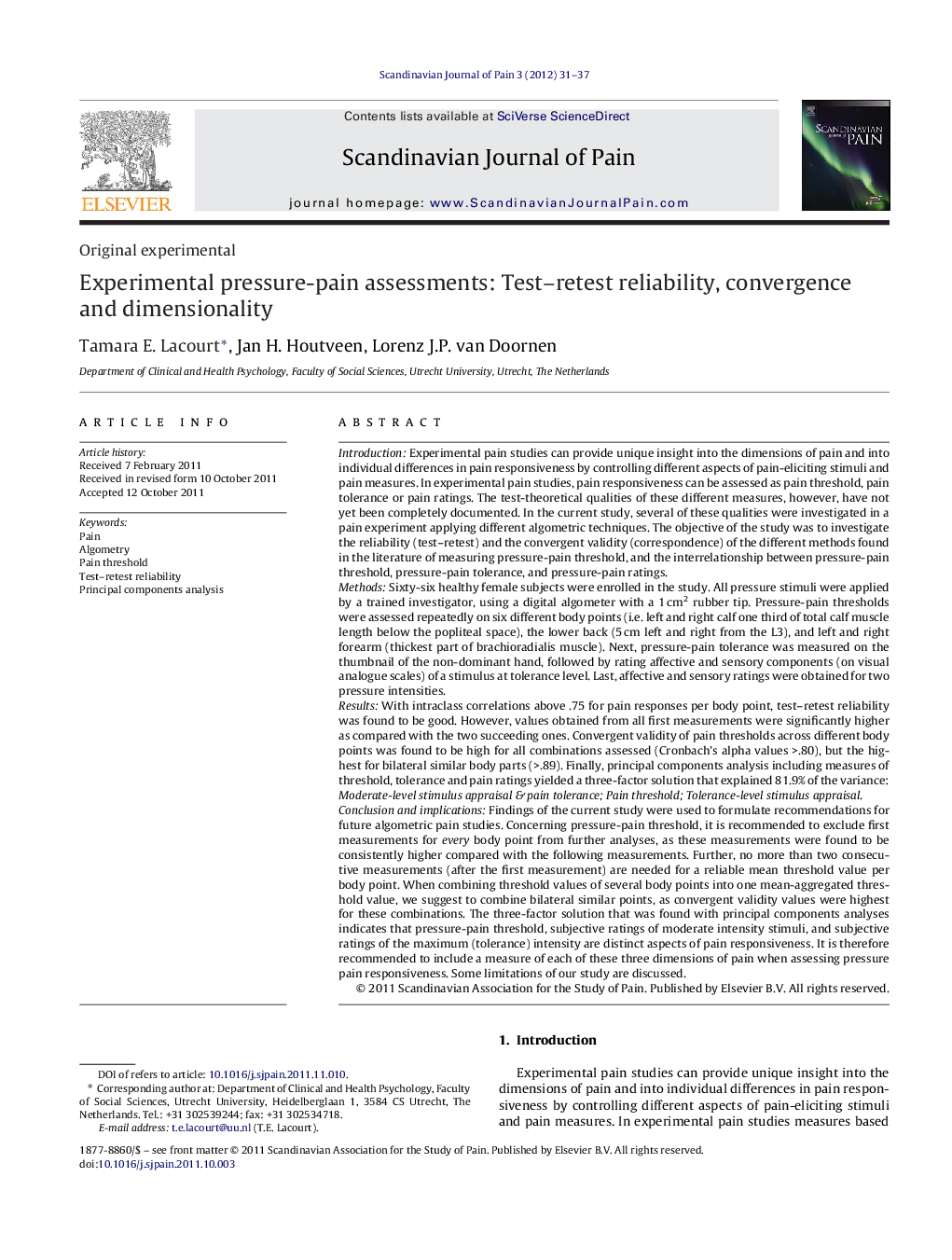| کد مقاله | کد نشریه | سال انتشار | مقاله انگلیسی | نسخه تمام متن |
|---|---|---|---|---|
| 2771054 | 1567826 | 2012 | 7 صفحه PDF | دانلود رایگان |

IntroductionExperimental pain studies can provide unique insight into the dimensions of pain and into individual differences in pain responsiveness by controlling different aspects of pain-eliciting stimuli and pain measures. In experimental pain studies, pain responsiveness can be assessed as pain threshold, pain tolerance or pain ratings. The test-theoretical qualities of these different measures, however, have not yet been completely documented. In the current study, several of these qualities were investigated in a pain experiment applying different algometric techniques. The objective of the study was to investigate the reliability (test–retest) and the convergent validity (correspondence) of the different methods found in the literature of measuring pressure-pain threshold, and the interrelationship between pressure-pain threshold, pressure-pain tolerance, and pressure-pain ratings.MethodsSixty-six healthy female subjects were enrolled in the study. All pressure stimuli were applied by a trained investigator, using a digital algometer with a 1 cm2 rubber tip. Pressure-pain thresholds were assessed repeatedly on six different body points (i.e. left and right calf one third of total calf muscle length below the popliteal space), the lower back (5 cm left and right from the L3), and left and right forearm (thickest part of brachioradialis muscle). Next, pressure-pain tolerance was measured on the thumbnail of the non-dominant hand, followed by rating affective and sensory components (on visual analogue scales) of a stimulus at tolerance level. Last, affective and sensory ratings were obtained for two pressure intensities.ResultsWith intraclass correlations above .75 for pain responses per body point, test–retest reliability was found to be good. However, values obtained from all first measurements were significantly higher as compared with the two succeeding ones. Convergent validity of pain thresholds across different body points was found to be high for all combinations assessed (Cronbach's alpha values >.80), but the highest for bilateral similar body parts (>.89). Finally, principal components analysis including measures of threshold, tolerance and pain ratings yielded a three-factor solution that explained 81.9% of the variance: Moderate-level stimulus appraisal & pain tolerance; Pain threshold; Tolerance-level stimulus appraisal.Conclusion and implicationsFindings of the current study were used to formulate recommendations for future algometric pain studies. Concerning pressure-pain threshold, it is recommended to exclude first measurements for every body point from further analyses, as these measurements were found to be consistently higher compared with the following measurements. Further, no more than two consecutive measurements (after the first measurement) are needed for a reliable mean threshold value per body point. When combining threshold values of several body points into one mean-aggregated threshold value, we suggest to combine bilateral similar points, as convergent validity values were highest for these combinations. The three-factor solution that was found with principal components analyses indicates that pressure-pain threshold, subjective ratings of moderate intensity stimuli, and subjective ratings of the maximum (tolerance) intensity are distinct aspects of pain responsiveness. It is therefore recommended to include a measure of each of these three dimensions of pain when assessing pressure pain responsiveness. Some limitations of our study are discussed.
► Methodological issues in measuring pressure-pain responsiveness were addressed.
► Pain threshold and pain ratings are distinct aspects of pain responsiveness.
► In measuring pain threshold, one practice trial per body point is recommended.
► Pain thresholds should be mean-aggregated over multiple body points.
► Bilateral combinations of pain-threshold points are recommended.
Journal: Scandinavian Journal of Pain - Volume 3, Issue 1, January 2012, Pages 31–37